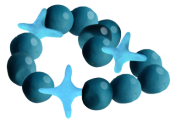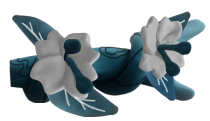

English 305 Fall 2020


Culture is not simply the people within it. It is the objects those people have, the food they make, the things they find value in, the environment that surrounds them, and the
creatures that interact with. All these things are interconnected in some way, some fashion, even as they seem silly to compare them. The wool of sheep becomes a sweater that
is worn, that becomes valuable in a society for its warmth. A tree is chopped down, valued for its wood, becoming fuel for food to be made, which is sold to somebody to eat.
A fox is hunted, prized for its fur and meat, becoming food, clothing, and part of the environment of the town as it becomes part of some persons home. I could list countless
other examples (which I won’t), where these concepts converge and meet and then split off to each other to become part of human culture, the human experience, the human self.
The purpose of this book, moreso multi-media online gallery, is to show these connections that ingrain themselves within culture, through Food, Treasure, Equipment,
Enviroment, and Wildlife (Both real and mythological). All of these things make reference, interact, destroy, create, poke, and prod each other as culture is created.
We see these relations appear again and again,even as societies move centuries apart.
Beowulf and The Tempest share meads and wines, Chevrefoil and Sir Gawain personify plants, and the clothes of the Canterbury Tales
find themselves in comparison to The Fairie Queene. I use the art of clay to connect of all them, with all the clay illustrations (of the icons and the dividers) being created
from a singular, blue ball of Plasticine (digitally recolored).
In another sense, the use of Black and White illustration becomes a blended mass of these concepts, never one story, always several intertwined in these small scenes.
It is true the art of a culture reflects its ideals, its traits they wish to be remembered for. While Beowulf can symbolize the gold idealizing early medieval culture,
something like the Tempest can become the Renaissance’s look into the theatre. Sir Gawain plays with the concepts of Chivalry and Honor of the Romance stories of the Middle
Ages, while the poetry of Sir Walter Ralegh explores the questions of life and romance itself. Perhaps it is simply the humans never really change, not a lot atleast. While
society evolves, the basic nature of humanity may stay the same, we may still enjoy being drunk, putting humans traits on the natural world, and the odd linens and cloths we
wrap ourselves in will always be of curiosity to prior and future generations.
Simply put, the art of Creation and Conversation links all culture together.


John Milton, Paradise Lost, Book 1 Lines 1-4
"Of man's first disobedience, and the fruit Of that forbidden tree, whose mortal taste Brought death into the world, and all our woe, With loss of Eden"
John Milton’s first few lines describing the story of Adam and Eve, positions the apple as this awakening object. It is "mans first disobedience" which is characterized by a "mortal taste" that creates man from the strangled beginnings of the paradise of Eden. Milton characterizes this mortality as death, however there must also be life. The apple is both Food and the Environment, it is mans will to interact with the natural world. |

Beowulf Lines 830-835 "Unremitting humiliations, The hard fate they’d been faced to undergo, No small affliction. Clear proof of this Could be seen in the hand the hero displayed High up near the roof: the whole of Grendels Shoulder and arm, his awesome grasp”
The Arm of Grendel is a trophy, it is a sign of victory; It is also a demonstration of the inhumane strength that Beowulf wielded, the ability to tear of a beasts massive arm and display it from the roof timbers. It’s a symbol of the Medieval ideals, strength, victory, adeptness in battle, and the ability to show proof of one’s prowess in life and over the wildlife that exists. It is the ability to grab life by the hand and step up once more from the humilations one faces, the paying back of a “wergild” with ones own life. |

Sir Gawain and the Green Knight Lines 161-167 "In all vestments he revealed himself veritably verdant! From his belt hooks and buckle to the baubles and gems Arrayed so richly around his costume And donning the saddle, stitched onto silk. All the details of his dress are difficult to describe, Embroidered as it was with butterflies and birds, Green beads emblazoned on a background of gold.”
The Green Knight's clothing is described so richly detailed, vertiably deep in its appearance, like the foliage of a tree populated by birds and butterflies. It is characterized like an enviroment in itself, as the Green Knight is this personiifaction of nature. It creates this link between Clothing and the Natural World, where one becomes the other, and the other is the one. The enviroment, the clothing, so rich, complex, and intricate that its hard to describe all the cycles, details, and life that goes on within a poem, a song, a story. |

Sir Walter Ralegh, The Nypmhs Reply to the Shepard Lines 1552-1618 "Time drives the flocks from fields to fold When rivers rage and rocks grow cold, And Philomel becometh dumb; The rest complains of cares to come. The flowers do fade, and wanton fields To wayward winter reckoning yields; A honey tongue, a heart of gall, Is fancy’s spring, but sorrow’s fall. Thy gowns, thy shoes, thy beds of roses, Thy cap, thy kirtle, and thy posies Soon break, soon wither, soon forgotten- In folly ripe, in reason rotten."
The Nymphs Reply to the Shepard by Sir Walter Ralegh presents the connection to nature that human society has, but it does so in reverse. The nymph says how nature fades, the flowers will wilt, and the fields that man has made will perish to winter just as anything else. She goes on to say though, that all the clothes, the performative beauty of flowers, and the society itself fades as well. It presents this connection, that human society is like nature, that it will fade with time, that societies fade, that winter (in this personification of time) takes its toll on everything. A blanket of snow suffocates everything, everything breaks, and withers, and is forgotten. |

The Tempest, Act 2, Scene 2 CALIBAN "But they'll nor pinch, Fright me with urchin--shows, pitch me i' the mire, Nor lead me, like a firebrand, in the dark Out of my way, unless he bid 'em; but For every trifle are they set upon me; Sometime like apes that mow and chatter at me And after bite me, then like hedgehogs which Lie tumbling in my barefoot way and mount Their pricks at my footfall; sometime am I All wound with adders who with cloven tongues Do hiss me into madness."
Caliban, as this punished native next to Ariel, is this symapthetic character. He is enslaved by Prospero, afraid of the spirits he possesses despite the fact Ariel is the one who holds all the power, and Caliban himself has the power to survive. He presents Prospero's power as this force of nature, these natural dangers of mires and urchin shows, hedgehogs pricking his feet, and adders who curse him, the natural world is under Prospero's power yet Caliban is the one who knows the island. Prospero becomes a represenitive of the colonizer, this creature that shapes the natural world until the native cannot recognize the land he was born and lived in. |